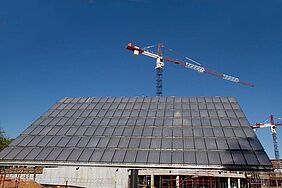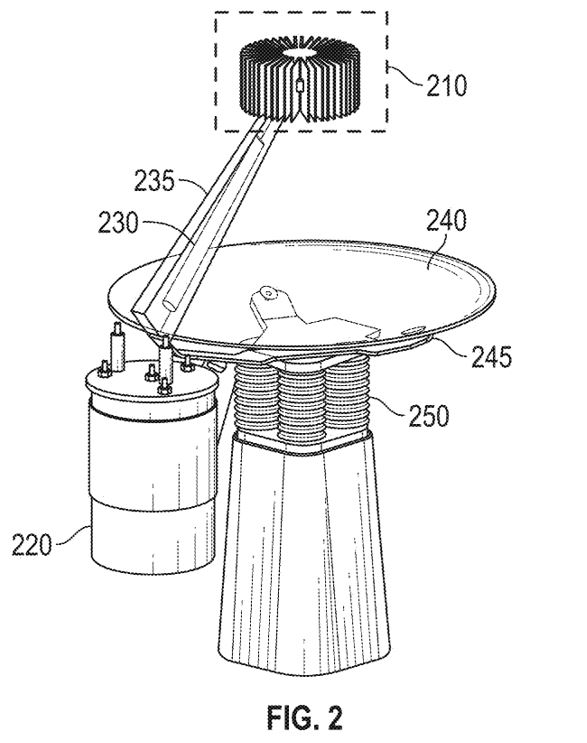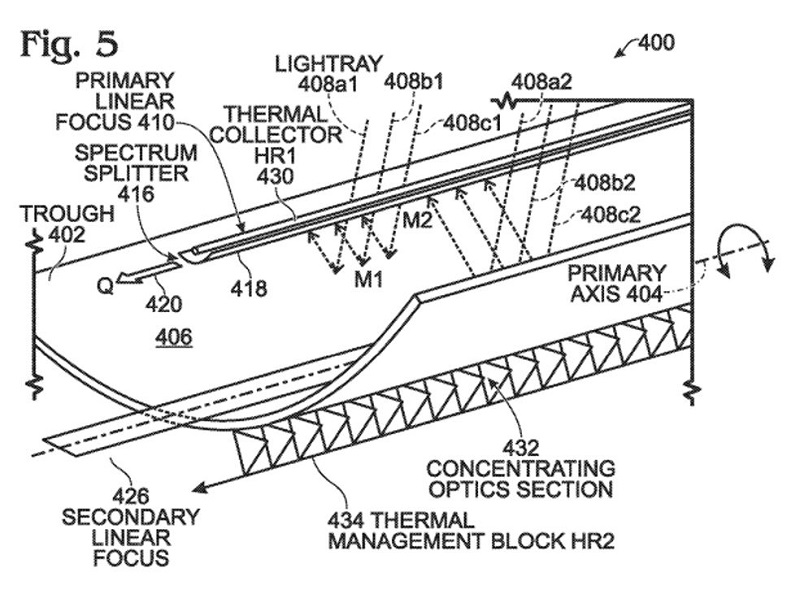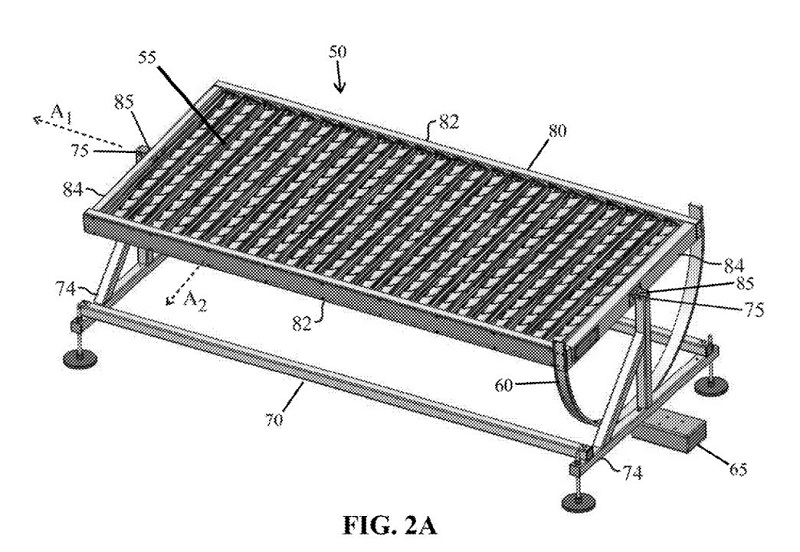Aenert news. Invention analysis
Earlier, we published a series of articles dedicated to solar energy technologies, where we covered energy storage systems (05.06.2022 and 09.01.2023), solar tracking modules (20.06.2022, 22.12.2022, 27.03.2023), and experimental and unconventional solutions (08.04.2023).
This time we are revising patent documents disclosing technical solutions related to Concentrating photovoltaics (CPV). We have collected more than 14000 patent documents published over the past 20 years to analyze using the Advanced Energy Technologies methodology. Patents and patent applications have been published in 59 patent offices around the world by 4258 applicants from 62 countries.
Solar energy. Concentrating photovoltaics. Cumulative number of patents and applications*, relationship of number of applications to total number of documents by year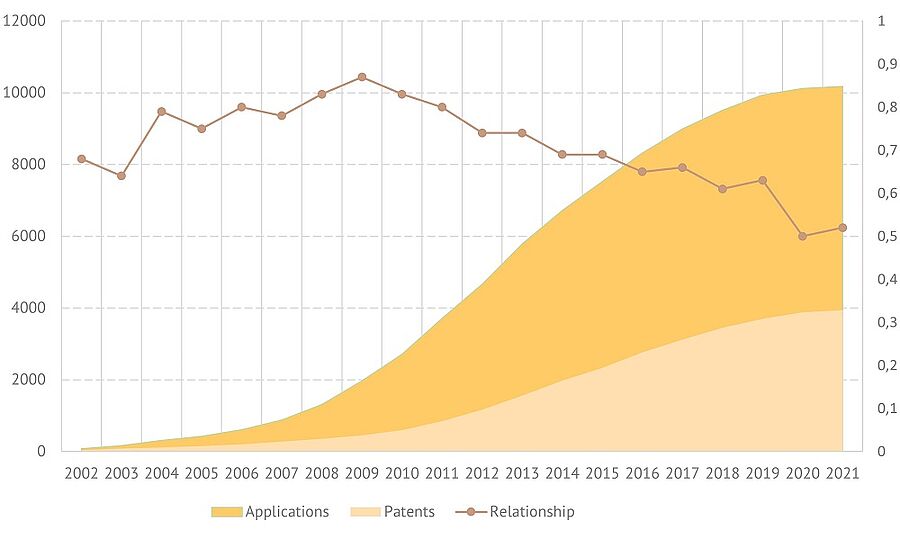
*Areas representing patents and applications are overlapping
In the collection of documents used for this analysis, the peak values in the number of granted patents were achieved in 2013-2016. In the case of patent applications, the highest number of registered documents was in 2011-2015, followed by a moderate decline. In recent years, the number of start documents that didn’t belong to any previously formed patent family declined from about 50% to about 10%.
A peak of new IPC subgroups appearing in the pool of documents related to the subject under consideration, can be seen in 2010-2016 with a slight decline afterwards. The number of new applicants was moderate in recent years after the peak in 2011-2013, while the number of patent offices declined noticeably. This may indicate slightly declining interest of the authors in the development of this field of technology, and, particularly, in developing new markets.
In the collection of documents under revision, the largest number of patents were granted during 20 years in the USPTO (US) patent office – about 32% of all patents. CNIPA (CN) and JPO (JP) were following the leader with almost 18% and almost 10%, respectively. EPO, KIPO (KR), IP Australia (AU), TIPO (TW), and Rospatent (RU) should also be mentioned as the offices each having a substantial number of patents in the field. In the pool of recent patent applications, CNIPA (CN) was in the lead with more than 30%. It was followed by USPTO (US) with more than 22% and WIPO with around 12%.
Solar energy. Concentrating photovoltaics. Breakdown of inventions by patent offices. Patents, 20 years (left); Applications, 5 years (right)

By the number of patents granted during the 20-year period, residents of the United States were leading with a share of more than 37% of all cases, followed by the residents of Japan (around 13%) and Germany (about 9%). For recently published patent applications, the leaders were the residents of the United States (about 32%), China (almost 27%), and Japan (around 13%).
Below is a list of top 10 applicants having the highest Market involvement ratio for patents published in the 20-year period (Market involvement ratio = volume ratio multiplied by ownership ratio, where Volume ratio - share of applicant documents in total number of documents, Ownership ratio - applicant's participation share in total number of documents):
Solar energy. Concentrating photovoltaics. Top applicants by Market involvement ratio. Patents
| Status | Country | Name | Volume ratio, % | Ownership ratio, % | Market involvement ratio, % |
|---|---|---|---|---|---|
| Company | US | SunPower Corporation | 4.04 | 91.30 | 3.69 |
| Company | JP | Sumitomo Electric Industries, Ltd. | 3.07 | 98.82 | 3.03 |
| Company | US | 3M Innovative Properties Company | 1.52 | 91.97 | 1.40 |
| Company | US | Boeing Company | 1.30 | 86.01 | 1.12 |
| Company | ES | Abengoa Solar New Technologies, S.A. | 1.28 | 91.10 | 1.17 |
| Organization | DE | Fraunhofer-Gesellschaft zur Förderung der Angewandten Forschung e.V. | 1.28 | 68.03 | 0.87 |
| Company | TW | Hon Hai Precision Industry Co., Ltd. | 1.28 | 77.87 | 1.00 |
| Company | US | International Business Machines Corporation | 1.19 | 83.68 | 1.00 |
| Company | JP | Kyosemi Corporation | 1.17 | 87.21 | 1.02 |
| Company | CA | Saint-Augustin Canada Electric Inc. | 0.95 | 93.10 | 0.88 |
Of all applicants participating in the reviewed collection of patents, SunPower Corporation (US) had the largest number of documents – 149. It was followed by Sumitomo Electric Industries, Ltd. (JP) - 113, and 3M Innovative Properties Company (US) – 56. The following applicants were the leaders by the number of documents in the collection of recently published patent applications: Sumitomo Electric Industries, Ltd. (JP) – 173, Chengdu Juhe Technology Co. Ltd (CN) – 74, and Bolymedia Holdings Co. Ltd (US) – 70.
Solar energy. Concentrating photovoltaics. Top applicants by Market involvement ratio. Applications
| Status | Country | Name | Volume ratio, % | Ownership ratio, % | Market involvement ratio, % |
|---|---|---|---|---|---|
| Company | JP | Sumitomo Electric Industries, Ltd. | 9.39 | 99.61 | 9.35 |
| Company | CN | Chengdu Juhe Technology Co. Ltd | 4.02 | 100 | 4.02 |
| Company | US | Bolymedia Holdings Co. Ltd | 3.80 | 92.86 | 3.53 |
| Company | US | Brilliant Light Power Inc | 2.55 | 100 | 2.55 |
| Company | US | SunPower Corporation | 2.28 | 100 | 2.28 |
| Company | CA | Saint-Augustin Canada Electric Inc. | 1.84 | 100 | 1.84 |
| Organization | FR | Commissariat à l'énergie atomique et aux énergies alternatives | 1.79 | 90.91 | 1.63 |
| Company | US | NEXTracker Inc. | 1.52 | 100 | 1.52 |
| Company | CN | Bolymedia Holdings Co Ltd | 1.19 | 84.09 | 1.00 |
| Company | US | International Business Machines Corporation | 1.14 | 96.83 | 1.10 |
In the collection of patent documents describing concentrating photovoltaics technologies, the most commonly mentioned problems were Low efficiency of optics or absorber, High costs of equipment production, and High costs of repair and replacement. In general, both patents and patent applications were presented in the form of devices. Methods can also be met in a substantial number of documents, while compositions are encountered significantly less often. The most popular IPC subgroups assigned to the patent documents under revision were: H01L31/052 (Cooling means directly associated or integrated with the PV cell, e.g. integrated Peltier elements for active cooling or heat sinks directly associated with the PV cells); H01L31/042 (PV modules or arrays of single PV cells); H02S40/22 (Light-reflecting or light-concentrating means); H01L31/054 (Optical elements directly associated or integrated with the PV cell, e.g. light-reflecting means or light-concentrating means); H02S20/32 (specially adapted for solar tracking).
In the pool of documents under revision, the largest patent family comprises 54 patent documents and is represented by core document AU2015288769A1 (Core document is a base document for which a complete description of the invention is available in generally-accessible patent databases). It is followed by patent families with core documents US20160072027A1 and AU2009246639B2, comprising 46 and 37 documents, respectively:
Wiring board and solar power generating device / A: AU2015288769A1 / IPC: H01L31/05, H01L31/054 / Toya Kazumasa, Iwasaki Takashi, et al. / Sumitomo Electric Industries / Appl. date: 06/07/2015; Publ. date: 12/01/2017 / IP Australia / Core document: AU2015288769A1 / Technology categories: CPV / Technology elements: SW / Problems: LEOA / Technical solution types: D / Claims: 17 / Rating: 11
Optical systems fabricated by printing-based assembly / A: US20160072027A1 / IPC: H01L25/16, H01L33/54, H01L33/56 / Rogers John, Nuzzo Ralph, et al. / X-Celeprint Limited, Univ Illinois, Semprius Inc / Appl. date: 15/07/2015; Publ. date: 10/03/2016 / United States Patent and Trademark Office / Core document: US20160072027A1 / Technology categories: CPV / Technology elements: O / Problems: HCEP, HCRR, LEOA / Technical solution types: D / Claims: 21 / Rating: 13
Method of manufacturing large dish reflectors for a solar concentrator apparatus / P: AU2009246639B2 / IPC: C03B23/025, C03B23/035 / Angel Roger P, Olbert Blain H / Arizona Board of Regents on Behalf of University of Arizona / Appl. date: 08/05/2009; Publ. date: 22/11/2012 / IP Australia / Core document: AU2009246639B2 / Technology categories: CPV, E / Technology elements: O / Problems: HCEP / Technical solution types: M / Claims: 11 / Rating: 14
The following abbreviations are used in the documents hereinbefore and hereinafter: C - Composition; D - Device; M - Method; CPV - Concentrator photovoltaics; SH - Storage CSP or Hybrid CSP; HCEP - High costs of equipment production; HCG - High costs in general; HCRR - High costs of repair and replacement; LEG - Low efficiency in general; LEOA - Low efficiency of optics or absorber; LESE - Low efficiency of secondary equipment; LESM - Low efficiency due to solar movement; LFR - Linear Fresnel reflector; R - Receivers; SW - System as a whole.
Solar energy. Concentrating photovoltaics. Breakdown of documents by family size. Patents and applications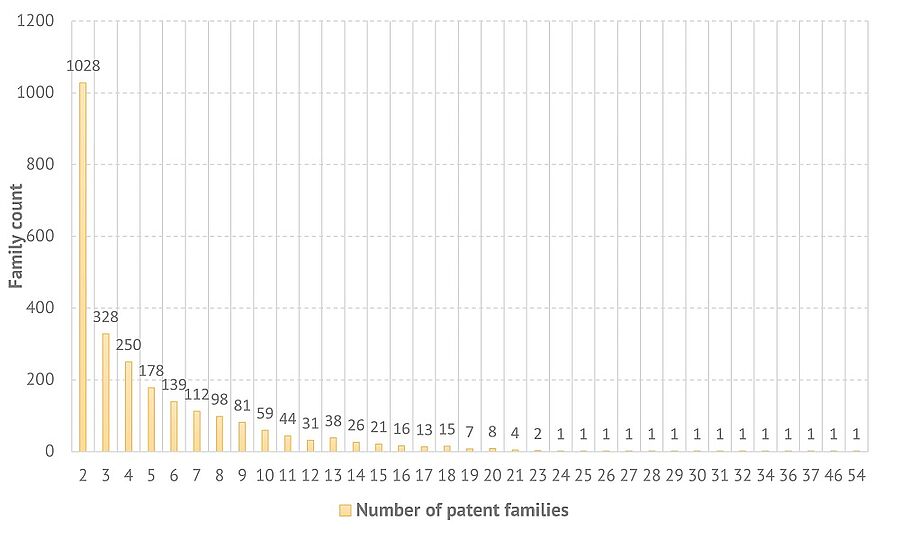
Several examples of technical solutions related to concentrating photovoltaics and having the highest rating calculated using Advanced Energy Technologies methodology are provided below:
Solar energy. Concentrating photovoltaics. Prominent patent documents by rating:
Group-iv solar cell structure using group-iv or iii-v heterostructures / P: US10896990B2 / IPC: H01L31/0725, H01L31/0687, H01L31/074, H01L31/0745, H01L31/078 / King Richard R, Fetzer Christopher M, Karam Nasser H / Boeing Co / Appl. date: 25/04/2018; Publ. date: 19/01/2021 / United States Patent and Trademark Office / Core document: US20180248067A1 / Technology categories: CPV / Technology elements: R / Problems: HCEP, HCRR, LEOA / Technical solution types: C, D, M / Claims: 23 / Rating: 21
Combustion system having improved temperature resistance / P: US10103309B2 / IPC: F23B10/00, F23C3/00, F23M5/00, F24S20/20, F24S20/40, H01L35/30 / Ollier Emmanuel, Mantzaras Ioannis / Commissariat A Lenergie Atomique Et Aux Energies Alternatives / Appl. date: 19/01/2016; Publ. date: 16/10/2018 / United States Patent and Trademark Office / Core document: US20160211436A1 / Technology categories: CPV, SH / Technology elements: SW / Problems: HCRR, LESE, LESM / Technical solution types: D, M / Claims: 19 / Rating: 20
Group-IV solar cell structure using group-IV or III-V heterostructures / P: US10811553B2 / IPC: H01L31/0687, H01L31/0725, H01L31/0735, H01L31/074, H01L31/0745, H01L31/078, H01L31/18 / King Richard R, Fetzer Christopher M, Karam Nasser H / Boeing Co / Appl. date: 28/02/2018; Publ. date: 20/10/2020 / United States Patent and Trademark Office / Core document: US20180190851A1 / Technology categories: CPV / Technology elements: R / Problems: HCEP, HCRR, LEOA / Technical solution types: D, M / Claims: 20 / Rating: 20
Light collection and concentration system / P: US8320045B2 / IPC: G02B27/10, H01L31/00, H01L31/042 / Martinez Anton Juan Carlos, Pereles Ligero Oscar, et al. / Abengoa Solar New Technologies, S.A. / Appl. date: 04/08/2009; Publ. date: 27/11/2012 / United States Patent and Trademark Office / Core document: US8320045B2 / Technology categories: CPV, LFR / Technology elements: SW / Problems: HCG, HCRR, LEOA / Technical solution types: D / Claims: 28 / Rating: 20
Multijunction solar cell having patterned emitter and method of making the solar cell / P: US10593818B2 / IPC: H01L31/0352, H01L31/0216, H01L31/0224, H01L31/028, H01L31/0296, H01L31/0304, H01L31/032, H01L31/061, H01L31/0725, H01L31/074, H01L31/078, H01L31/18 / Fetzer Christopher M, Hebert Peter / Boeing Co / Appl. date: 09/12/2016; Publ. date: 17/03/2020 / United States Patent and Trademark Office / Core document: US20180166602A1 / Technology categories: CPV / Technology elements: R / Problems: LEOA / Technical solution types: C, D, M / Claims: 28 / Rating: 20
Optoelectronic device with heat spreader unit / P: US8860162B2 / IPC: H01L31/0203 / Linderman Ryan, Dawson Matthew, Suez Itai / Sunpower Corporation, Linderman Ryan, Dawson Matthew, Suez Itai / Appl. date: 26/09/2011; Publ. date: 14/10/2014 / United States Patent and Trademark Office / Core document: US8530990B2 / Technology categories: CPV / Technology elements: SW / Problems: HCEP, HCRR, LEG / Technical solution types: D / Claims: 20 / Rating: 20
Polymerizable liquid composition and process for the production of organic glass starting from polymerizable liquid compositions of the polyurethane type / P: US8829147B2 / IPC: B29D22/00, C08G18/10, C09K19/00, C08L75/00, C08J5/00, C08G18/70, C08G18/30, E06B3/00, B32B3/02, B32B27/00, B32B27/40, B64C1/10, B64C1/14, G02C7/02, G02B6/00, F16L9/00, C08G18/28, C08G18/22, C08G18/08, C08G18/00, B64D17/02, B64D7/00 / Bos Willem, Renzi Fiorenzo, et al. / Acomon AG, Bos Willem, et al. / Appl. date: 14/10/2009; Publ. date: 09/09/2014 / United States Patent and Trademark Office / Core document: US20110251301A1 / Technology categories: CPV, LFR / Technology elements: SW / Problems: HCEP, HCRR, LEOA / Technical solution types: C, D, M / Claims: 11 / Rating: 20
Three main groups of documents that can be outlined in the present collection of patents and patent applications with regard to technology elements they can be associated with, are Receivers, Optics, and Trackers. Following are several examples of technical solutions that relate to concentrating photovoltaics and concern the above technology elements:
- US11004995B2 - lower costs of a photovoltaic device are achieved by a system that includes a convex lens with chromatic aberration, two photoelectric converters located in different positions and having different bandgaps and largest spectral sensitivities at different wavelengths;
- US11482967B2 - improved efficiency of capturing solar energy is achieved by a concentrated solar photovoltaic and photothermal system comprising a solar concentrator, a partially transparent photovoltaic module, and a thermoplate that absorbs and converts unabsorbed infrared light into thermal heat;
- US10608134B2 - improved efficiency is achieved by a CPV system using two-stage light concentration with independently rotatable concentrating imaging optics sections, optical funnels, and a reflecting trough;
- US20210036654A1 - improvements in efficiency, and investment and maintenance costs are achieved by a system having a light concentrating trough with reflective inner and outer surfaces and a double-sided light receiver between the walls of the trough. The system comprises at least two sets of such devices, where the opening of the second device faces the ridge of the first device;
- US20200067451A1 - a solar energy collection system where a frame is rotated by a pre-stretched wire cable connected to a hoop and a drive. The drive comprises a drive pulley with partially wrapped cable that is tensioned and has two segments connected to the drive pulley and to the opposing sides of the hoop. The invention is aimed at reducing the adverse effect of development of additional slack in the tracker.
Receivers
Patent US11004995B2 granted on 11.05.2021 to Kaneka Corporation proposes a photovoltaic device that includes a convex lens with chromatic aberration, a first photoelectric converter on the optical axis of the lens arranged on an inner side of a condensing region of absorbable longest-wavelength light based on the bandgap, and a second photoelectric converter on an outer peripheral side of the first converter and having a bandgap lower than a that of the first converter. The first converter has the largest spectral sensitivity at a first wavelength, and the second converter – at a longer wavelength. The converters can include an antireflection film or texture structure on the light receiving surface. The materials for the first converter can be cadmium sulfide, amorphous silicon, indium gallium phosphide, perovskite semiconductor, cadmium telluride, or gallium arsenide, and for the second converter, germanium, copper indium selenide, crystalline silicon, polycrystalline silicon, or microcrystalline silicon.
The invention is aimed at reducing the costs of photovoltaic device production.
The patent belongs to a family comprising 7 patent documents published in 2018-2021 in WO, JP, CN, EP, and US.
Image from: US11004995B2
1 - photovoltaic device; 10 - condensing optical system; 11 - first photoelectric converter; 12 - second photoelectric converter; 21 - focal point of short-wavelength light; 22 - focal point of long-wavelength light; f1 - first focal plane; f2 - second focal plane; f3 - third plane.
Patent US11482967B2 published on 25.10.2022 by The Administrators of the Tulane Educational Fund discloses a concentrated solar photovoltaic and photothermal system that includes a solar concentrator, a partially transparent photovoltaic module near its focal point, and a thermoplate. The system concentrates sunlight using the solar concentrator, directing it onto the photovoltaic module located near the focal point. The infrared portion of the sunlight that is not absorbed by the photovoltaic module passes through a receiving aperture on the thermoplate. The thermoplate is made of two welded metal sheets, forming a serpentine or manifold structured channel with a plurality of dimples that mix heat-transfer fluid flowing inside. The interior cavity of the thermoplate absorbs and converts the unabsorbed infrared light into thermal heat. The heat is conducted from the interior cavity into the heat-transfer fluid flowing through the structured channel. The device also includes an inlet port and an outlet port through which heat-transfer fluid flows in and out of the structured channel, and a thermal energy storage unit. The thermoplate is thermally isolated from the photovoltaic module to reduce heat flow between them. The system can be used to generate thermal heat for various applications.
The authors claim that the invention achieves "…high efficiencies while capturing and storing solar thermal energy".
The patent belongs to a family comprising 9 patent documents published in the WO, CA, AU, CN, EP, and US patent offices between 2018 and 2022.
Image from: US11482967B2
210 - thermal receiver; 220 - thermal energy storage (TES) tank; 230 - HTF piping system; 240 - parabolic dish; 250 - bellows-based actuator.
Optics
Patent US10608134B2 by NorCon Technologies LLC describes a concentrating photovoltaic system with two-stage light concentration. The system comprises multiple independently rotatable optics sections positioned in series along a secondary linear focus, each comprising an imaging optical element, focusing R band wavelengths along a tertiary linear focus. The system further comprises multiple optical funnels along the tertiary linear focus concentrating the R band wavelengths to a number of receiving areas with PV devices. The optical funnels are hollow with inner reflective surfaces, preferably have a form of CPC and are made of a dielectric material with exterior surface facets. The system further comprises a concentrating reflective trough having a parabolic curved surface, a dichroic spectrum splitter having a hyperbolically curved surface, a thermal collection tube, and thermal cooling blocks attached to the PV devices.
The authors mention improved efficiency in terms of optimum collection of energy.
The patent is a part of a family comprising 7 patent documents published in WO, US, EP, and CN in 2016-2020.
Image from: US10608134B2
400 - the system; 406 - parabolic curved surface; 418 - hyperbolically curved surface; 420 - axis; M1 - primary mirror; M2 - dichroic mirror.
Patent application US20210036654A1 by Bolymedia Holdings Co Ltd and Hu Xiaoping describes a light-concentrating solar apparatus that includes a light concentrating trough with reflective surfaces and a double-sided light receiver arranged between the walls of the trough. The receiver has front and back surfaces capable of receiving sunlight and includes a double-sided photosensitive light-energy utilization device, or two single-sided photosensitive devices facing opposite directions. The system comprises at least two sets of such devices, where the outer surfaces of the concentrating trough of the first set are reflective and the trough of the second set is arranged so that its opening faces the ridge of the first trough. The claims of the invention also specify additional configurations, features and elements of the system, such as Fresnel lens, water heater, ambient covers, light guiding devices, etc.
With regard to the prior-art solutions, the authors mention such drawbacks as high initial investment and maintenance costs, and aim to improve the efficiency of solar power conversion.
The application belongs to a patent family comprising 5 documents published between 2019 and 2021 in WO, CN, US, EP, and JP.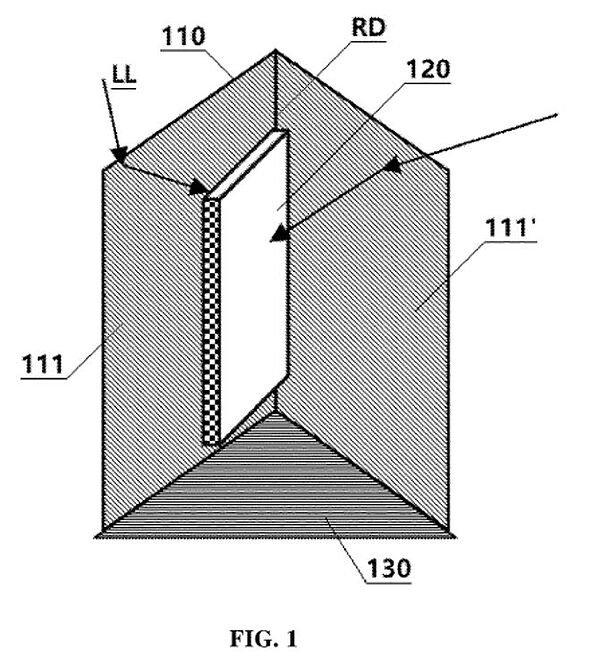
Image from: US20210036654A1
110 - light concentrating trough; 111,111' - walls; 120 - light receiving device; 130 - reflective panel; LL - sunlight; RD - ridge.
Trackers
Patent application US20200067451A1 by Raydyne Energy Inc and Knox Richard Morris discloses a solar energy collection system comprising a stand with first opposing ends and rotation points, a frame with second opposing ends and rotational points disposed on the first rotational points of the stand to rotate the frame about a first axis by a drive positioned on the stand. The system further comprises a hoop on the frame that defines a curvature about the first axis, and a pre-stretched wire cable that connects the hoop and the drive and rotates the frame with a collector. The drive comprises a drive pulley defining a helical groove in which the cable partially wraps. The cable has two segments, one ends of which are connected to the drive pulley, while the opposing ends are connected to the opposing sides of the hoop. The cable is tensioned by a tensioner comprising a turnbuckle, an idler pulley, a biasing element, a catch, or their combination.
The invention is aimed at reducing the drawbacks of the prior-art solutions, such as development of additional slack in the drive mechanism and their effect on overall performance of the system.
The application belongs to a patent family comprising 4 patent documents published in 2017 and 2020 in the US and WO patent offices.
Image from: US20200067451A1
A1 - first axis of rotation; A2 - second axis of rotation; 50 - solar concentrator system; 55 - solar collectors; 60 - hoop pulley; 65 - drive motor; 70 - stand or base unit; 74 - first opposing ends; 75 - first rotational points; 80 - frame; 82 - side of frame; 84 - second opposing ends; 85 - second rotational points.
During the analysis of these and other inventions from the collection of patent documents in the field of concentrating photovoltaics, it can be seen that the proposed technical solutions are highly diversified, they include adaptations of conventional CSP approaches to CPV, hybrid systems where both thermal and photovoltaic energy converters are used, and highly specific solutions that can only be used with semiconductors. It was discovered though, that there is a considerable number of patent documents aiming at addressing the problem of excess heat produced in CPV systems, which appears to be a major concern for inventors in this field.
More detailed information about inventions in the field of solar energy, and patent research methodology can be found on aenert.com, in SOLAR ENERGY. Solar Trackers. Extended patent report. June 2022, and CONCENTRATED SOLAR POWER. Energy Storage. Patent Database. May 2022.
By the Editorial Board
